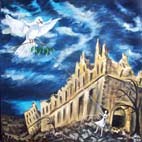 "Freedom" 2010 photograph by Lorraine Beattie
"Freedom" 2010 photograph by Lorraine Beattie
Preparations for Legato 2014, part of the commemorations for the seventieth anniversary of the end of the battles for Cassino, are well underway. Over 100 artworks by 37 New Zealanders will be on display in Cassino, and 12 artists are planning to be here in person. The exhibition is also being supported by the Ngati Ranana culture group from London.
The opening event is at 1pm on Saturday 17 May in the Sala Pietro Malatesta, Biblioteca Comunale, when the exhibition will be opened by His Excellency Dr Trevor Matheson, New Zealand Ambassador to Rome.
A second opening event and blessing will be at the Historiale on Sunday 18th at 4.30pm when the exhibition by guest exhibitor Maree Wilks is formally opened (it will be able to be viewed prior to this).
Legato was established by New Zealand curator and organiser Kay de Lautour Scott in 2010 after discussions in London and in Italy with veteran Douglas Lyne (1921-2010), founder of the Monte Cassino Foundation for Remembrance and Reconciliation, about the role of the arts in international understanding and cultural exchanges in peace work.
Exhibitions to date:
2010 Cassino, Italy (NZ artists with German & Italian NZ artists)
2010 Roccasecca (FR) Italy (NZ artists)
2011 Wallace Gallery, Morrinsville, New Zealand (NZ artists)
2011 Cassino, Italy (NZ, Canadian & Italian artists)
2012 Cassino, Italy (NZ, Canadian, Hungarian, English & Italian artists)
2012 Roccasecca (FR), Italy (NZ, Canadian & Italian artists)
2013 Monte San Giovanni in Campano, Italy (selected NZ artwork)
2013 Cassino, Italy (NZ, Canadian, Italian, Russian, USA & English artists)
While essentially a New Zealand exhibition, approximately 60 artists of seven different nationalities have contributed to Legato to date.
To help newcomers to Legato find their way around the blog and videos, here are some useful links.
The history of Legato (blog post)
Why "Legato"? (blog post)
A range of videos:
Mosaic artist Janice Corbishley discusses
her work and involvement in the Legato Exhibition
Painter Jon Stevenson
explains his artwork and his trip to Cassino
Mixed media artist Frances Rookes
interview at Legato
Photographer Lorraine Beattie
interview at Legato
Italo-Kiwi Margherita Giampietri discusses her work and the logistics and benefits of taking part in international exhibitions, and compares Italian and NZ post-war experiences
video
General background and artist comments (2010):
Legato at Cassino (video)
The opening in 2010: Legato opening
(video, short version)
Artists hold a short service of remembrance at the
Commonwealth cemetery (video)
The first Legato exhibition, Cassino Italy 2010 (blog post)
Legato on Vimeo
(click here for link to 15 videos)
Thanks to Nicola Blackmore of feijoafilms (Scotland and Melbourne) for travelling to Italy to produce these videos in 2010.
Legato on Facebook:
https://www.facebook.com/pages/Legato-Exhibition-Italy/109656259065551?fref=ts































